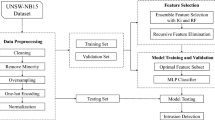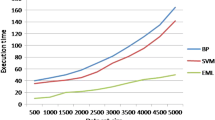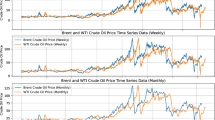Abstract
Extreme learning machine for single-hidden-layer feedforward neural networks has been extensively applied in imbalanced data learning due to its fast learning capability. Ensemble approach can effectively improve the classification performance by combining several weak learners according to a certain rule. In this paper, a novel ensemble approach on weighted extreme learning machine for imbalanced data classification problem is proposed. The weight of each base learner in the ensemble is optimized by differential evolution algorithm. Experimental results on 12 datasets show that the proposed method could achieve more classification performance compared with the simple vote-based ensemble method and non-ensemble method.

Similar content being viewed by others
References
Zhang D, Islam MM, Lu G (2012) A review on automatic image annotation techniques. Pattern Recogn 45(1):346–362
Garcia-Pedrajas N, Perez-Rodriguez J, Garcia-Pedrajas MD, Ortiz-Boyer D, Fyfe C (2012) Class imbalance methods for translation initiation site recognition in DNA sequences. Knowl Based Syst 25(1):22–34
He H, Garcia EA (2009) Learning from imbalanced data. IEEE Trans Knowl Data Eng 21(9):1263–1284
Tang Y, Zhang YQ, Chawla NV, Krasser S (2009) SVMs modeling for highly imbalanced classification. IEEE Trans Syst Man Cybernet B 39(1):281–288
Liu X, Wu J, Zhou Z (2009) Exploratory undersampling for class-imbalance learning. IEEE Trans Syst Man Cybernet B 39(2):539–550
Zhou Z, Liu X (2006) Training cost-sensitive neural networks with methods addressing the class imbalance problem. IEEE Trans Knowl Data Eng 18(1):63–77
Sun Y, Kamel MS, Wong AKC, Wang Y (2007) Cost-sensitive boosting for classification of imbalanced data. Pattern Recogn 40(12):3358–3378
Galar M, Fernandez A, Barrenechea E, Bustince H, Herrera F (2012) A review on ensembles for the class imbalance problem: bagging-, boosting-, and hybrid-based approaches. IEEE Trans Syst Man Cybern C Appl Rev 42(4):463–484
Xue X, Yao M, Wu Z, Yang J (2014) Genetic ensemble of extreme learning machine. Neurocomputing 129:175–184
Zhu QY, Qin AK, Suganthan PN, Huang GB (2005) Evolutionary extreme learning machine. Pattern Recogn 38(10):1759–1763
Storn R, Price K (1997) Differential evolution–a simple and efficient heuristic for global optimization over continuous spaces. J Global Optim 11(4):341–359
Price K, Storn R, Lampinen J (2005) Differential evolution: a practical approach for global optimization”. Springer, Berlin
Huang GB, Zhu QY, Siew CK (2006) Extreme learning machine: theory and applications. Neurocomputing 70:489–501
Zong W, Huang GB, Chen YQ (2013) Weighted extreme learning machine for imbalance learning. Neurocomputing 101:229–242
Li K, Kong X, Lu Z, Liu W, Yin J (2014) Boosting weighted ELM for imbalanced learning. Neurocomputing 128:15–21
Yu Q, Heeswijk M, Miche Y, Nian R, He B, Séverin E, Lendasse A (2014) Ensemble delta test-extreme learning machine (DT-ELM) for regression. Neurocomputing 129:153–158
Mirza B, Lin Z, Toh KA (2013) Weighted online sequential extreme learning machine for class imbalance learning. Neural Process Lett 38(3):465–486
Huang GB, Song S, Gupta J, Wu C (2014) Semi-supervised and unsupervised extreme learning machines. IEEE Trans Cybernet 44(12):2405–2417
Xia SX, Meng FR, Liu B, Zhou Y (2015) A kernel clustering-based possibilistic fuzzy extreme learning machine for class imbalance learning. Cognit Comput 7(1):74–85
Mao W, Wang J, Xue Z (2016) An ELM-based model with sparse-weighting strategy for sequential data imbalance problem. Int J Mach Learn Cybernet. doi:10.1007/s13042-016-0509-z
Mirza B, Lin Z, Liu N (2015) Ensemble of subset online sequential extreme learning machine for class imbalance and concept drift. Neurocomputing 149:316–329
Cao JW, Lin ZP, Huang GB, Liu N (2012) Voting based extreme learning machine. Inf Sci 185(1):66–77
Feng G, Qian Z, Zhang X (2012) Evolutionary selection extreme learning machine optimization for regression. Soft Comput 16(9):1485–1491
Cao JW, Lin ZP, Huang GB (2012) Self-adaptive evolutionary extreme learning machine. Neural Process Lett 36:285–305
Miche Y, Sorjamaa A, Bas P, Simula O, Jutten C, Lendasse A (2010) OP-ELM: optimally pruned extreme learning machine. IEEE Trans Neural Netw 21(1):158–162
Liang NY, Saratchandran P, Huang GB, Sundararajan N (2006) Classification of mental tasks from EEG signals using extreme learning machine. Int J Neural Syst 16(1):29–38
Huang GB, Chen L (2007) Convex incremental extreme learning machine. Neurocomputing 70(16):3056–3062
Huang G, Huang GB, Song S, You K (2015) Trends in extreme learning machines: a review. Neural Netw 61:32–48
Mukherjee R, Patra GR, Kundu R, Das S (2014) Cluster-based differential evolution with crowding archive for niching in dynamic environments. Inf Sci 267:58–82
KEEL dataset repository. http://sci2s.ugr.es/keel/imbalanced.php
Acknowledgments
This work is partly supported by National Natural Science Foundation of China (No. 61373127) and the State Key Laboratory for Novel Software Technology (Nanjing University) of China (No. KFKT2015B16).
Author information
Authors and Affiliations
Corresponding author
Rights and permissions
About this article
Cite this article
Zhang, Y., Liu, B., Cai, J. et al. Ensemble weighted extreme learning machine for imbalanced data classification based on differential evolution. Neural Comput & Applic 28 (Suppl 1), 259–267 (2017). https://doi.org/10.1007/s00521-016-2342-4
Received:
Accepted:
Published:
Issue Date:
DOI: https://doi.org/10.1007/s00521-016-2342-4




